The Trevi fountain stands in the Quirinale district of Rome and is officially recognised as one of the best-looking fountains in the world. In Rome, there were more than 1350 fountains in the 4th century so you can imagine the stiff competition. If you have seen the movie La Dolce Vita you will be able to recognise the scene when Anita Ekberg jumps into the Trevi with all her clothes on.
The fountain has also been featured in several other movies like Roman Holiday, Lizzie Mcguire movie and Three Coins in the Fountain. The Trevi is famous for being the largest Baroque fountain in the world and it’s arguably the prettiest too. The Trevi signals its presence from afar by the gushing sound of its water and the cool mist that permeates the air as you walk towards it. This makes finding the Trevi quite easy though it’s always flanked by lots of crowds and stands in the middle of a relatively small Piazza.
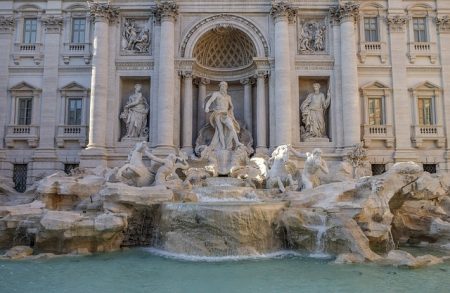
History
The fountain dates back to historic Roman times when the Aqua Virgo Aqueduct was constructed in the 19th B.C. This aqueduct used to pump water to the Roman baths and most fountains of central Rome. The Aqua Virgo or the Virgin Waters are so named after a young Roman girl who led famished soldiers towards spring water to quench their thirst. True to its name the Trevi demarcates the point where Aqua Vergine, Aqua Virgo and an unnamed aqueduct met.
A fountain had lived at the Trevi fountain location since ancient times but it was in 1629 the Pope Urban VII had commissioned Gian Lorenzo Bernini to sketch designs for renovations. After the subsequent death of the Pope the project was shelved indefinitely though some of Bernini’s suggestions were translated in designs about 100 years later.
The fountain was strategically built at the last point of the aqueduct at the meeting point of three roads. These trio of streets i.e. tre vie (in Roman) gave the Trevi fountain its name that is the Three Street Fountain.
Back in 1730, Pope Clemens XII held a contest to design a new fountain. Many renowned architects participated but at last Nicola Salvi won the design rights of the fountain. Some historians, however, say that Alessandro Galilei who was an architect from the astronomer Galileo’s family had won the project commission but public outrage led the project to be granted to Salvi. Incidentally, the outcry was about a nativity bias as Galilei was a Florentine and Salvi a native Roman. Salvi then chose the principal sculptor Giovanni Battista who created the central sculpture of the fountain but then he died before the work was finished. The rest of the sculpture was finished by Pietro Bracci.
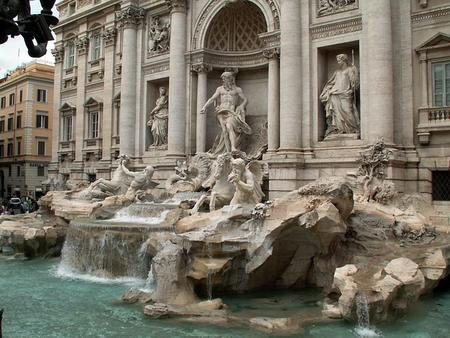
Salvi was not fortunate enough to see his fountain inaugurated. The first gush of water sprouted out of the fountain in 1743 but it was only in 1762 that Pope Clement XIII chose an architect named Giuseppe Pannini who gave the Trevi fountain its final touches before it was inaugurated and this was 11 years after Salvi died of pneumonia.
It is said that in those times Rome was going through a cash crunch and Salvi had proposed the least expensive project for building the fountain. This was said to be partly the reason as to why Pope Clement chose Salvi for the project. Interestingly that year the Lotto was reintroduced in Rome and the entire money from the lotto game was used to finance the fountain. The lucky numbers were 56, 6, 11, 18 and 54. The fountain was built from travertine stone that literally translates to ‘from the Tiber’.
This stone was made of calcium carbonate that was formed from spring waters especially the hot springs of Tivoli that’s 22 miles away from Rome. That’s the same arterial that was used to build the mighty Colosseum. The Trevi fountain construction history is littered with tragedies…many workers were injured and a stonecutter was horrifically killed by a huge travertine block in 1734.
The beautiful Baroque fountain became infested with rats and in 2012 some pieces of the gorgeous cornice started falling away after a very harsh winter.
Unfortunately like the Colosseum and the Spanish steps, the Romans did not treat the Trevi fountain well. Rats, pigeons, chewing gum and maltreatment by several locals and tourists disfigured the fountain and damaged its water drainage system. Its La Dolce Vita fame even inspired several deranged people to try and recreate the scene inside attracting huge fines and media attention and causing a lot of damage to the monument. The damage from the groundwater and subsidence was so great that it was starting to separate the fountain from the Palazzo Conti.
The iconic fashion house Fendi finally stepped in to bail out the cash strapped Italian government by pouring in a massive 2.2. Million euros for a 17-month restoration project. The project started in 2014 and finally ended in November 2015 after which the public was able to see the water gushing out of the Trevi again. Incidentally, Fendi was also gracious enough to build a temporary bridge that gave the public a close view of the Baroque fountain up close as well as installing a small temporary fountain in which the public could still toss coins, while the 17-month restoration project was on.
The Fendi project completely remodelled the fountain and gave it a new look besides an advanced pigeon deterrent system (pigeons had contributed hugely in disfiguring the monument earlier) and refurbished pumps. A grand high tech lighting system with 100 LED lights and fantastic night light installations was also a part of the restoration project. The Trevi now looks lovelier than ever thanks to the 2.2 million euros Fendi pumped in it.
Recently (in 2017) one of the most gorgeous fashion shows ever was staged by Fendi to mark the 90th anniversary of the brand. Models and celebrities like Bella Hadid and Kendall Jenner floated across a carefully constructed and perfectly transparent Plexiglas runway across the Trevi. This isn’t the first public monument to be used for fashion shows; the Spanish steps have been frequently used for the same. The show titled ‘legends and fairy tales’ conceptualised an enchanted forest full of magic and till date is referred to as the ‘Grandest fashion show ever’.
What To See & Do
The Trevi fountain is 85 feet tall and almost 65 feet in width. At your first glimpse of it you should be floored by its beauty and size before it strikes you how similar Rome’s management of civic spaces is. The Trevi like many other monuments is set like a theatre and the Piazza slopes gradually with a right side that’s higher up than the left. A curved row of seats is built into the fountain front giving it a cinematic appearance.
Water gushes out of multiple sources and the huge pool in front and the fountain spills out 2824800 cubic feet of water each day. However, the whole amount of water is recycled and the Romans are great at waste management. When you are around the fountain you might notice people throwing coins in it over their shoulder. It’s estimated that nearly 3000 euros are thrown in the fountain every day.
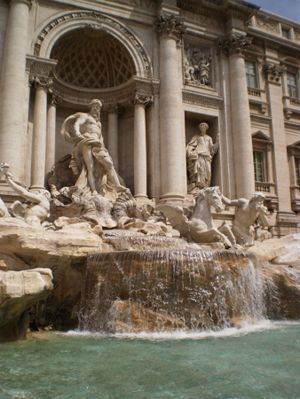
Local lore says that each coin thrown in the Trevi will bring rich returns to Rome. Some say that throw in one coin for luck (and if you want to return to Rome) and two for love and three if you want to get married fast; you can imagine the number of enthusiastic coin throwers. In order to achieve the desired results, the coins must be thrown with the right hand over the left shoulder.
More interesting is the fact that each night all the coins are collected and are given away to an Italian charity named Caritas. This company uses the funds for a supermarket program and gives out rechargeable cards to Rome’s poor to help them buy groceries. Earlier thieves used to plunder coins from the Trevi fountain and some of them were caught by a TV Show that used a hidden camera in 2011. One such legendary Trevi fountain coin thief was d’Artagnan who siphoned coins from the fountain for 34 years before he was nabbed in summer of 2002.
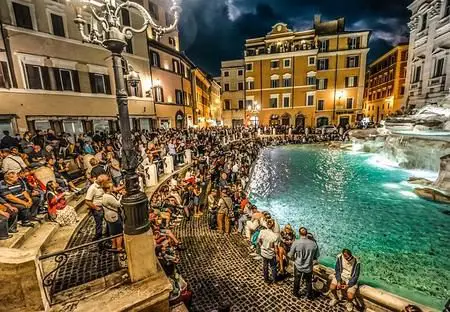
To appreciate Rome’s unique and rewarding relationship with water it’s important to recognise that its talented engineers were able to create incredible tasks. Precisely devised aqueducts enabled water from surrounding hills to flow to the city utilising the laws of gravity. The water was stored in large cisterns that created a big energy vacuum before it sprayed out of hundreds of dedicated fountains. Rome had hundreds of fountains… nose-shaped ones with a simple design but sometimes the upper crust of the society chose to create fountains that represented the Italian art aesthetic. The Trevi fountain is the best example of this.
Note the finely crafted image of Oceanus/ Neptune; the God of water in the centre of the fountain niche…he is being pulled by a chariot drawn by seahorses. One of the seahorses is wild and the other docile and they represent the opposing forces of the sea. The largest cascade keeps glimmering like a glass sheet as it emerges from the bluish basin lip and hits the rocks under.
The deities of Salubrity and Abundance flank Oceanus. On the left is Abundance who is holding a horn of plenty and an upturned vase lies at her feet. There is a relief right on top of her that shows Agrippa commanding his generals to construct the aqueduct. The statue of health is to the right of the main arch and she is crowned with laurel wreaths. In her hands is a cup from which a serpent drinks water. There is a relief above her that shows a beautiful Virgin showing soldiers the source of water. This lady inspired the name of the major aqueduct that feeds the Trevi fountain i.e. Aqua Virgo. If you look over the head of Neptune/ Oceanus then you will see an inscription that validates the final inauguration of the fountain i.e. 1762.
Below the trio of Gods are many tritons and hippocampus who add beautiful symmetry to the fountain. Two tritons lead the horses on each side and one of them holds a conch shell to announce their arrivals. It’s said that the Conch shell has mythical powers to control the ocean waves. At the crest of the fountain, there is the Papal Coat of Arms which is suspended by angels. The theme behind the Trevi fountain is the philosophy of taming the waters…a reference to the aqueducts that flood the fountain with water bringing in abundance and health.
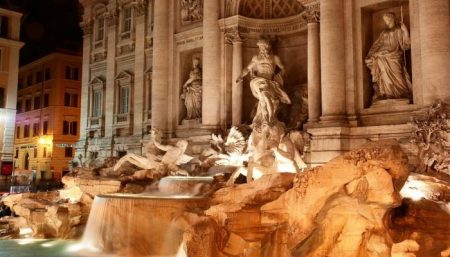
Towards the top of the fountain, there are 4 beautiful statues that are perched atop pillars. These show the benefits of rain on the earth and the biggest produce groups that hinge on water supply. The Abundance of Fruits is holding a Horn of Plenty and Fertility of Crops is holding an earful of wheat. The Products of Autumn hold a cup and a luscious bunch of grapes and the Joy of Prairie and Gardens is bedecked with blooms.
The façade and the whole fountain and reliefs boast of incredibly beautiful work. Such is the finesse of the artists that the signs of erosion deliberately etched into the right side of the façade look absolutely real. Notice the wreath of ethereal flowers carved right above…they will give you a correct idea of the skill level of the ancient Roman stone cutters.
The right edge of the fountain has an urn that was built by the fountain architect in order to obstruct the view of the fountain from a local barbershop on the adjoining street (these two were at loggerheads apparently). Look towards the right of the steps and there is a very small fountain. There is a custom for newlyweds who believed that it was lucky to drink from its waters and then smash the glass afterwards as a symbol of fidelity.
You can find various options for entry and tours of Trevi Fountain (including combination tours with other attractions) and book online from this Viator site.
Some say that the Piazza di Trevi should be renamed as the Piazza di Gelato as the best Gelato shops in Rome are cantered here. Admire the fountain, get your picture clicked and get the most awesome gelato ever from one of the umpteen shops near the fountain. There is a lovely old-world feel to this square that will encourage you to sit and have pizza and wine or maybe a heartier meal while admiring the buzz.
However sadly Rome has been unable to escape the clutches of modernisation; there is a United Colours of Benetton shop on the fountain square that spoils the antique atmosphere of the Piazza Trevi. You might want to wander on the main promenade too leaving the fountain to your left; it’s filled with local art vendors who sell exquisite stuff. And obviously, the best activity to do near any Roman heritage attraction is to walk; you can easily walk to the Spanish Steps, Pantheon etc. from here. Many tour operators offer fountain oriented walks too if you are especially interested in the beautiful fountains of Rome.
Points to Remember
Virginia Raggi (Rome’s Mayor) has implemented a series of new rules effective from 2017 to protect the beautiful fountains of the city… you cannot sit on the fountains, feed your pets from them, wade through them or have water fights. All these are now punishable offences in Rome ranging upwards from 180 euros. You can, however, drink from the fountain (or the smaller one beside it) yourself or fill up your water bottle; it’s one of the few public fountains in Rome that still allows this.
Do ask one of the many guys strolling around with a camera to click a photo right when you are tossing a coin inside the fountain. Some of them will print out that click for just 5 euros.
It’s going to be incredibly crowded between 9 a.m. to 7 p.m. so try visiting before or after that. The Trevi fountain is one place that’s crowded even in the sweltering summer mid-day. At the night the newly installed light fixtures come to life and the fountains look enthralling. For getting the best experience pay a visit in the early morning around 7 a.m. and another visit around 10 p.m. or later. This way you can experience all its facets and hopefully get some pictures without a whole lot of other people in it.
This area (like most touristy areas in Rome) is full of pickpockets so keep your belongings safe. There are lots of people around who will try selling you everything from roses to selfie sticks so that’s a bit annoying.
Location & Contact Details
The Trevi fountain is on the Piazza di Trevi that’s a street which flanks the fountain on both sides. City buses or large vehicles never come up to here but many city buses do come up to the Via del Tritone which is almost 100 yards away.
The nearest metro station is Piazza Barberini which is a ten-minute walk away. Simply head west till you reach Via del Tritone and you will reach Via della Stamperia. Keep walking south following Via Stamperia till you reach Piazza di Trevi and you will see the fountain on your right. If you are on a hop on hop off bus tour then know that the Trevi stop is on Via del Tritone that’s just 3 blocks to the south of Piazza Barberini.
By the way, Piazza Barberini has the lovely Triton fountain that’s surely worth a close look and some great pictures. The Termini station is roughly a half an hour walk away from the Trevi fountain.
Address: Piazza di Trevi, Rome 00187
Phone: +39 06 0608; Website
What’s Nearby
The Spanish Steps is 7 blocks north to the Trevi fountain. The nearby metro step Piazza Barberini is a good place to spend some time; it was known once as Circus of Flora (the floral games were once held here). West to the Trevi fountain and 15 minutes away is the Pantheon.
And if you are really on your way to the Pantheon make a quick stop at the Piazza Navona that’s right next door. It has a gorgeous 3-fountain construct apart from many operas and theatre houses. If you are an avid walker then walk a bit more (9 blocks away) to gape at the gorgeously designed Augustus Mausoleum.
To know more about the Trevi Square you can visit the Citta Dell Acqua museum (very near the fountain). In 1999 an old cinema Trevi was being converted into a multiplex and this was when an entire Roman apartment with walls, toilets, stairs and herringbone floor was discovered submerged under the ground…all this dated back to 120 AD. These exhibits are housed in Citta dell museum….a testimony to the fact that there was a functional fountain in the Trevi neighbourhood even in the Middle Ages.
Once you are done sightseeing and if hunger pangs strike then there are a couple of great restaurants nearby. There is Melograno (Italian cuisine) just 100 meters away from the fountain and Le Tamerici with its French culinary offerings that’s about 700 meters away. But the Pizza at Pizza in Trevi is pure Italian and loaded with sumptuous toppings; don’t miss this nondescript looking place just 300 meters away from the fountain. This is a busy tourist square so there are no shortages of cafes, gelato shops and restaurants here.
 A travel addict. Still celebrating the day when he quit his high-profile corporate job to pursue his passion for travel writing.
A travel addict. Still celebrating the day when he quit his high-profile corporate job to pursue his passion for travel writing.